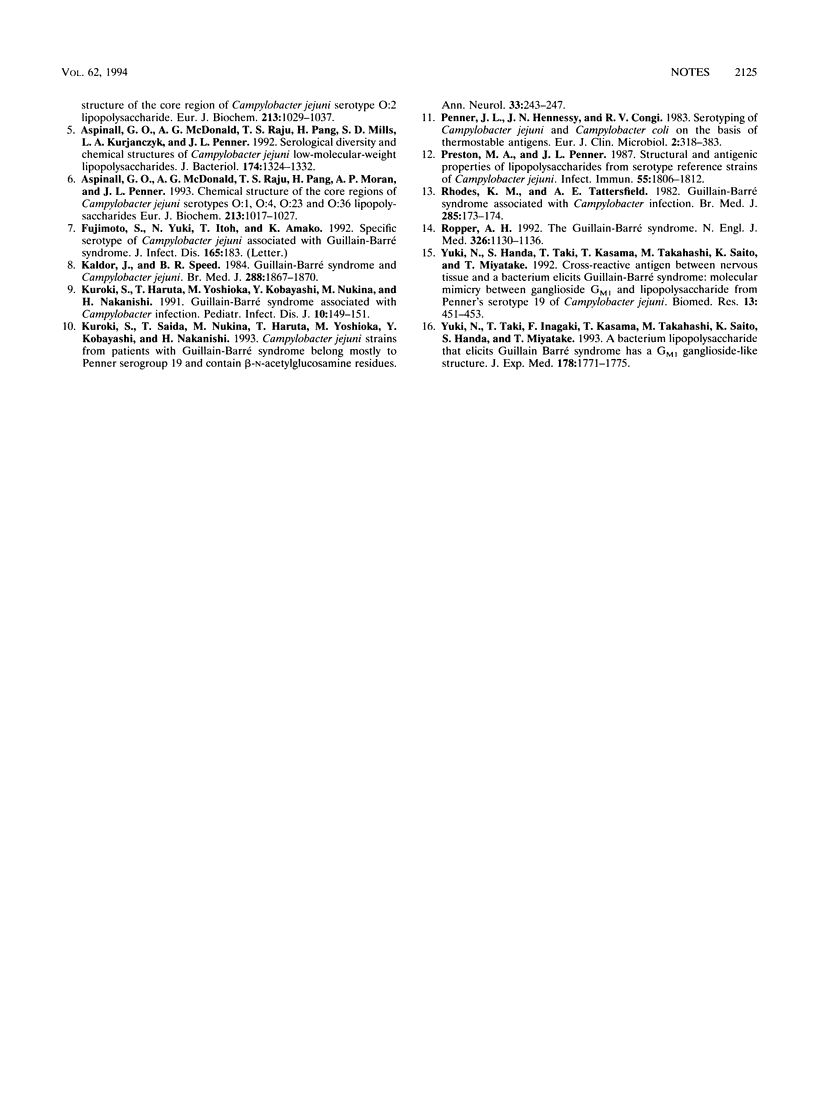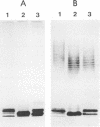Abstract
Lipopolysaccharides extracted from Campylobacter jejuni serostrains (serotype reference strains) for serotypes O:4 and O:19 were found to have core oligosaccharides with terminal structures resembling human gangliosides GM1 and GD1a. High-molecular-weight molecules that reflected the presence of O chains were shown in immunoblots to be immunologically specific for each serostrain. The O:19 antiserum also reacted strongly with core oligosaccharides of two isolates from patients with Guillain-Barré syndrome (GBS), but the banding patterns and molecular structures were different from those of the O:19 serostrain. A neuraminobiose disaccharide unit is attached to the terminal Gal residue in one isolate, and the other isolate lacked terminal N-acetyl glucosamine and galactose with attached sialic acid so that the sialic acid residues were present in a neuraminobiose unit linked to the only remaining galactose. Analysis of the high-M(r) lipopolysaccharides of the O:19 serostrain and the two isolates from GBS patients revealed the presence of a hyaluronic acid-like polymer with disaccharide-repeating units consisting of beta-D-glucuronic acid amidated with 2-amino-2-deoxyglycerol and N-acetyl glucosamine. The results confirm a potential role for the core oligosaccharides in the etiology of GBS but also suggest that the O-chain polysaccharide may be a contributing factor.
Full text
PDF



Images in this article
Selected References
These references are in PubMed. This may not be the complete list of references from this article.
- Aspinall G. O., McDonald A. G., Pang H., Kurjanczyk L. A., Penner J. L. Lipopolysaccharides of Campylobacter jejuni serotype O:19: structures of core oligosaccharide regions from the serostrain and two bacterial isolates from patients with the Guillain-Barré syndrome. Biochemistry. 1994 Jan 11;33(1):241–249. doi: 10.1021/bi00167a032. [DOI] [PubMed] [Google Scholar]
- Aspinall G. O., McDonald A. G., Pang H. Lipopolysaccharides of Campylobacter jejuni serotype O:19: structures of O antigen chains from the serostrain and two bacterial isolates from patients with the Guillain-Barré syndrome. Biochemistry. 1994 Jan 11;33(1):250–255. doi: 10.1021/bi00167a033. [DOI] [PubMed] [Google Scholar]
- Aspinall G. O., McDonald A. G., Pang H. Structures of the O chains from lipopolysaccharides of Campylobacter jejuni serotypes O:23 and O:36. Carbohydr Res. 1992 Jul 2;231:13–30. doi: 10.1016/0008-6215(92)84003-b. [DOI] [PubMed] [Google Scholar]
- Aspinall G. O., McDonald A. G., Raju T. S., Pang H., Mills S. D., Kurjanczyk L. A., Penner J. L. Serological diversity and chemical structures of Campylobacter jejuni low-molecular-weight lipopolysaccharides. J Bacteriol. 1992 Feb;174(4):1324–1332. doi: 10.1128/jb.174.4.1324-1332.1992. [DOI] [PMC free article] [PubMed] [Google Scholar]
- Aspinall G. O., McDonald A. G., Raju T. S., Pang H., Moran A. P., Penner J. L. Chemical structures of the core regions of Campylobacter jejuni serotypes O:1, O:4, O:23, and O:36 lipopolysaccharides. Eur J Biochem. 1993 May 1;213(3):1017–1027. doi: 10.1111/j.1432-1033.1993.tb17849.x. [DOI] [PubMed] [Google Scholar]
- Fujimoto S., Yuki N., Itoh T., Amako K. Specific serotype of Campylobacter jejuni associated with Guillain-Barré syndrome. J Infect Dis. 1992 Jan;165(1):183–183. doi: 10.1093/infdis/165.1.183. [DOI] [PubMed] [Google Scholar]
- Kaldor J., Speed B. R. Guillain-Barré syndrome and Campylobacter jejuni: a serological study. Br Med J (Clin Res Ed) 1984 Jun 23;288(6434):1867–1870. doi: 10.1136/bmj.288.6434.1867. [DOI] [PMC free article] [PubMed] [Google Scholar]
- Kuroki S., Haruta T., Yoshioka M., Kobayashi Y., Nukina M., Nakanishi H. Guillain-Barré syndrome associated with Campylobacter infection. Pediatr Infect Dis J. 1991 Feb;10(2):149–151. doi: 10.1097/00006454-199102000-00014. [DOI] [PubMed] [Google Scholar]
- Kuroki S., Saida T., Nukina M., Haruta T., Yoshioka M., Kobayashi Y., Nakanishi H. Campylobacter jejuni strains from patients with Guillain-Barré syndrome belong mostly to Penner serogroup 19 and contain beta-N-acetylglucosamine residues. Ann Neurol. 1993 Mar;33(3):243–247. doi: 10.1002/ana.410330304. [DOI] [PubMed] [Google Scholar]
- Penner J. L., Hennessy J. N., Congi R. V. Serotyping of Campylobacter jejuni and Campylobacter coli on the basis of thermostable antigens. Eur J Clin Microbiol. 1983 Aug;2(4):378–383. doi: 10.1007/BF02019474. [DOI] [PubMed] [Google Scholar]
- Preston M. A., Penner J. L. Structural and antigenic properties of lipopolysaccharides from serotype reference strains of Campylobacter jejuni. Infect Immun. 1987 Aug;55(8):1806–1812. doi: 10.1128/iai.55.8.1806-1812.1987. [DOI] [PMC free article] [PubMed] [Google Scholar]
- Rhodes K. M., Tattersfield A. E. Guillain-Barre syndrome associated with Campylobacter infection. Br Med J (Clin Res Ed) 1982 Jul 17;285(6336):173–174. doi: 10.1136/bmj.285.6336.173. [DOI] [PMC free article] [PubMed] [Google Scholar]
- Ropper A. H. The Guillain-Barré syndrome. N Engl J Med. 1992 Apr 23;326(17):1130–1136. doi: 10.1056/NEJM199204233261706. [DOI] [PubMed] [Google Scholar]
- Yuki N., Taki T., Inagaki F., Kasama T., Takahashi M., Saito K., Handa S., Miyatake T. A bacterium lipopolysaccharide that elicits Guillain-Barré syndrome has a GM1 ganglioside-like structure. J Exp Med. 1993 Nov 1;178(5):1771–1775. doi: 10.1084/jem.178.5.1771. [DOI] [PMC free article] [PubMed] [Google Scholar]




